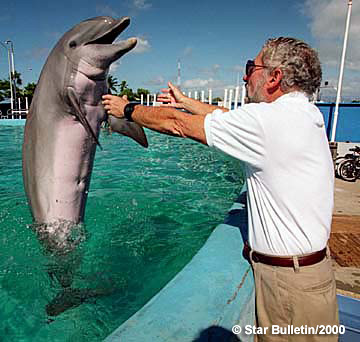The Great Researcher
A brilliant scientist who went too far
Dolphins and UsPart One: The Smartest of Us All? “So Long, and Thanks for All the Fish!” Amazing Abilities of Dolphins Dolphins or Humans: Who’s Smarter? Dolphin Society and Culture They’re Super-Brainy, Too More Fascinating Stuff The Great Researcher A Society that Works Are Dolphins “Persons” Life and Culture How Smart is a Dolphin? Experimenting on Dolphins My Visit to the Dolphins Other Links & Videos Mirror Self-Recognition Test The Herman Investigation The Minds of Whales |

Lou Herman’s story is a paradox. A brilliant scientist, Herman contributed greatly to our understanding of dolphins — as you’ll see in the videos below.
At the Dolphin Institute’s Kewalo Basin Marine Mammal Laboratory in Hawaii, he did the most remarkable research with captive dolphins. Indeed, most of what we know about dolphin intelligence, consciousness and self-awareness was learned from Herman’s work.
However, the captive dolphins paid the price. The last of them, Hiapo, died prematurely at age 20 in February, 2004. Her pool mates, Phoenix and Akeakamai, had both died of cancer a few months earlier, and it is thought that Hiapo, who was in good physical health, died of grief and loneliness.
An investigation into the three deaths concluded that Professor Herman was negligent in not stopping his work with Phoenix and Akeakamai and placing them in veterinary care. He was fined, and he gave up his work with captive dolphins.
The story of Professor Herman and “his” dolphins is tragic in the true meaning of the word. There’s no questioning his brilliance, his devotion to science, and his attachment to the dolphins at his laboratory. But what was the cost to the animals he “loved?” His failure to put Phoenix and Akeakamai first in his quest for knowledge is the classic story of a person of great ability and dedication who, unable to see beyond his quest and his possessive “love” brings death to others and downfall upon himself.
Ironically, the one thing Herman proved beyond all else was that dolphins do not belong in captivity. Nothing new of any value has been learned by other scientists who continue to study captive dolphins.
Herman’s work is captured in a BBC TV program with David Attenborough, which was produced shortly before the demise of the three dolphins. While Attenborough does not comment on the practice of keeping dolphins in captivity, he does show that the abilities that the dolphins show at Herman’s lab are not just clever party tricks. His footage of dolphins in the wild shows how their amazing abilities are critical to how they survive and thrive in the wild 50 million years after their ancestors – land mammals – returned to the ocean.
Next, Hiapo echolocates what’s hidden in a box:
Phoenix and Akeakamai make up a synchronized swimming routine in seconds. (This would take human Olympic teams months!)
These videos and Lou Herman’s work are a tribute and a fitting memorial to Phoenix, Akeakamai and Hiapo. It’s time to honor what they taught us by bringing an end to captive research on dolphins.
